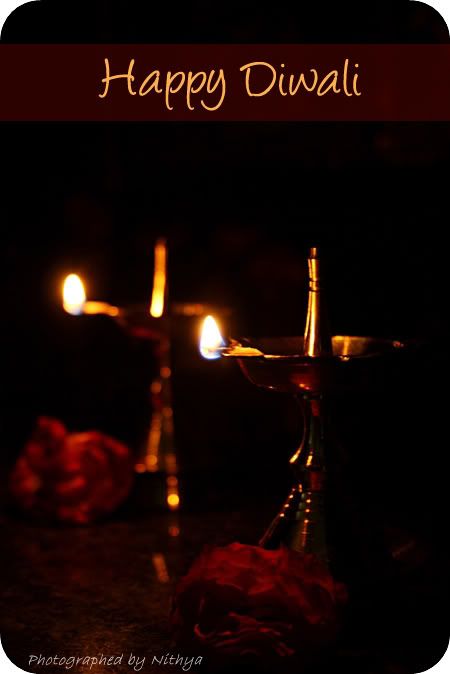
We had seen about the Hindu's belief of the festival as well as the Jain's reason for celebration in the previous posts. Now lets know a little about the celebration by the Sikhs. :)
Diwali is particularly important for the Sikhs because it celebrates the release from prison of the sixth guru, Guru Hargobind Ji and 52 other princes from the Gwalior Fort in 1619. This occasion is also called "Bandi Chorr Devas".
The Mughal Emperor Jahangir had imprisoned Guru Har Gobind and 52 other Hindu princes fearing the Guru's growing power. The Emperor was asked to release Guru Har Gobind which he agreed to do. However, Guru Har Gobind requested that the Hindu princes to be released, too. The Emperor agreed, but said only those who could hold onto his cloak tail would be allowed to leave the prison. This was in order to limit the number of prisoners who could leave.
However, Guru Har Gobind had made a cloak with 52 tassels and so each King was able to hold onto one tassel and leave the prison.
The Sikhs celebrated the return of Guru Har Gobind by lighting the Golden Temple and this tradition continues even today. :)
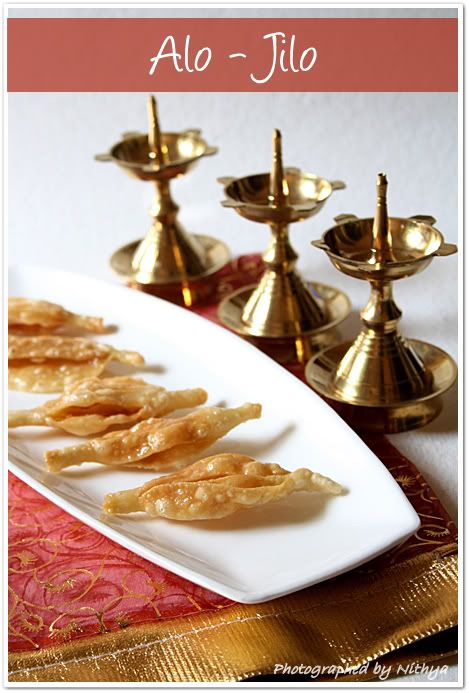
Got reminded of this sweet when I visited my friend, Lakshmi aunty for Golu. Since then I have been waiting to make it at home :)
Just like its cute name, the dish is as such cute looking and extremely yummy :)
The shape makes it very interesting for the kids and ofcourse young hearted grownups like me love it too :P
Enjoy this diwali with delicious, crispy and crunchy Alo Jilo :)

Maida(All purpose flour) - 2 cups
Vanaspati(Dalada) - 2 tblsp
Salt - a pinch
Cooking soda - 1/4 tsp
Powered Sugar - 1 cup
Oil - to fry
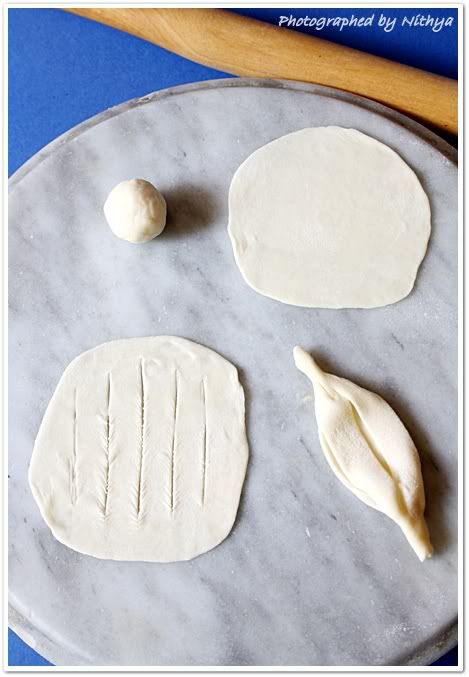
In a broad basin rub vanaspathi and soda together till it forms a frothy paste. Mix flour to this and blend well with finger tips till the mixture become crumbly.
Now add water little by little and kneed into a dough. leave it alone for ten mins.
Then, roll small balls of dough and flatten it out like roti. Now make around 5 slits on the roti using a sharp knife leaving alone a centimeter on the top and bottom. Carefully fold it twice and twist both the ends using your fingers. Hope the picture on top helps you to understand the pattern.
Make such pattern with all the dough you have made and leave them on a plastic sheet.
Now take oil in a pan and once it is medium hot, drop the alo jilo into the oil and fry them until they turn light brown on both the sides.
Spread powdered sugar on a flat plate. Drop the fried alo jilo on the powdered sugar and coat them with sugar on both the sides. Do this as soon as you take it out of the oil.
Alo jilo is ready to eat :)
Store it in an air tight box.
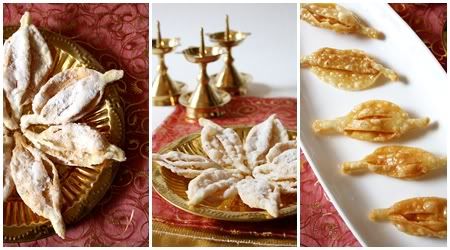
You can replace powdered sugar with sugar syrup.
Take 1 cup of sugar and 1/2 cup of water in a pan and allow it to boil till one string consistency.
Drop the alo jilo into the sugar syrup and coat it allover with syrup. Then remove it and keep it aside on a plate for a while. Alo jilo is ready :)
The quantity mentioned above gave me around 70 of them. :)
Happy making :)
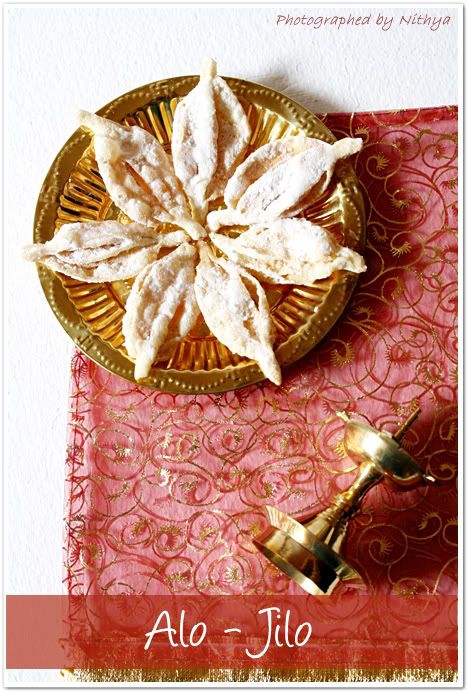

Wow Alo jilo looks super cute, love ur beautiful diyas u r using for ur presentation Nithya..Wishing you a happy and safe diwali dear..
ReplyDeleteJust love the presentation of your dishes..Amazing photography..Alo Jilo sounds damn cool..Happy Diwali and stay safe.
ReplyDeleteGayu
http://ensamayalarangam.blogspot.com
U r a total decorative lady with a foodie touch :) Happy and safe diwali to u n ur family :)
ReplyDeletefantastic Nithi ....all very unique dishes in this Damaka with very unique presentation .. love it love it
ReplyDeleteHavent heard or even tasted this ...Looks yum n beautiful presentation as well
ReplyDeleteAlo Jilo - interesting name!
ReplyDeleteWish you and your family a happy and safe Diwali.
Cute name and pictures are beautiful nithi. Wish you a very Happy Diwali.
ReplyDeleteLooks so delicious and beautiful..love the presentation.
ReplyDeleteWow nice post my favourite sweet this is learned from my friend.Nice for the Diwali treat.
ReplyDeleteAlo Jilo looks delicious. Nice post. Happy Diwali too you and your family.
ReplyDeleteThis is my fav recipe.. we call them Panasa Thonalu.. Looks amazing Nithya.. Awesome clicks.. Love them :)
ReplyDeleteAlo jilo is a new name for me, but looks delicious Nits..Happy Diwali to you too...
ReplyDeleteHappy Diwali to you too,Yummy Alo Jilo beautifully presented...
ReplyDeletesimplehomefood.com
we Bengalis call it Elo Jhelo. very well made and awesome potos.
ReplyDeleteHappy diwali dear.
Alo jilo looks so cute and totally loved your presentation.
ReplyDeleteWishing you and your family a very Happy Diwali :-)
This comment has been removed by the author.
ReplyDeleteHi Nits
ReplyDeleteTempting clicks as usual
yes i loved making this i called them as Banana flowers ...
loved this sweet with sweetness and crunchy to much on ..
you can have a look at them at my blog as well ...
http://itsallaboutfoodlovers.blogspot.com/2009/10/banana-flowers.html
Happy diwali to u and ur family members Nits .
wow! Very Interesting story .Happy Depavali and Yummy and crispy looking Sweet! Thanks for Sharing :)
ReplyDeleteHappy Deepavali Nitya. Great pictures here.
ReplyDeleterightly you have narrated the sikh's version of Diwali celebration with your "Alo jilo". (its like their "bhallee bhallae dance").The name itself makes the sweet very tempting!!The photos reveal the rich texture of the snack.HAPPY DIWALI :)
ReplyDeleteLovely Alo Jilo,nice name and lovely clicks :)
ReplyDeleteWishing you and your family a very happy Diwali :)
Happy diwali!! Have a great one!!
ReplyDeleteHi Nitya,
ReplyDeleteAll the Deepavali sweets and Savories collections are looking fantastic. The Diyas were perfect for the photography.
Wishing you and your family a happy Deepvali
hola, buenos dias
ReplyDeletecon su permiso tomonota de la receta, parece deliciosa
saludos des de catalunya ( barcelona) spain
susanna
Happy Diwali to you and all at home!
ReplyDeleteLove the name, the shape, the clicks... and everything here :) a wonderful post..
ReplyDeleteIt's been some time since I made this. The kids ( they were very young then) thought it was pretty creative - like japanese lanterns.
ReplyDeletewe bengalis call these elo jhelo, I think because of the shape..it seems these goodies are made allover India and are known in different names..beautiful presentation, Nithya
ReplyDeleteLovely presentation. Nice pictures too.
ReplyDeleteam still keeping one piece of it and asking ma mom ...how was this made..!!!
ReplyDeleteWhoah brings back sweet memories:)Thanks
ReplyDelete